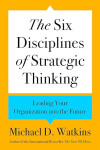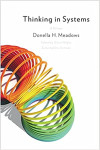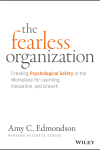Thinking in Systems
A Primer
"Thinking in Systems" provides a foundational framework for understanding how systems shape our world and how we can work with them more effectively. The book demystifies systems thinking by breaking down complex systems into their basic components: stocks, flows, and feedback loops.
The author introduces a practical methodology for analyzing systems, from simple mechanisms to complex organizations and ecosystems. Through this lens, readers learn to recognize common system behaviors, understand why systems work the way they do, and identify leverage points for meaningful change.
At its heart, the book bridges theoretical systems thinking with practical application, helping readers develop the skills to see systems in action and make better decisions within them. This includes understanding system archetypes, recognizing common pitfalls in system thinking, and learning how to work with system behavior rather than against it.
By reading "Thinking in Systems", you will:
- Master the fundamental elements of systems thinking: Learn to identify stocks, flows, and feedback loops in any system, enabling you to understand why systems behave the way they do and how to influence them effectively.
- Develop skills in system diagnosis and intervention: Understand how to analyze system behavior patterns and identify high-leverage intervention points, allowing you to make more effective changes in organizations and processes.
- Recognize and avoid common system traps: Learn to spot archetypal system problems like policy resistance and resource depletion, helping you prevent system failures before they occur.
- Build more resilient and sustainable systems: Understand the principles of system resilience, self-organization, and hierarchy to design and maintain systems that can withstand challenges and adapt to change.
Related books
- "The Fifth Discipline" by Peter Senge: Applies systems thinking specifically to organizational learning and development, building on many of the core concepts presented in Thinking in Systems.
- "Limits to Growth" by Donella Meadows: Written by the same author, this book applies systems thinking to global challenges and sustainability.
- "Complex Adaptive Systems" by John H. Miller and Scott E. Page: Provides a deeper dive into how systems adapt and evolve over time.
- "Design for the Real World" by Victor Papanek: Explores how systems thinking applies to design and problem-solving in practical contexts.
Stocks and Flows
The basic building blocks of systems. Stocks are elements that can be measured at any point (like water in a bathtub), while flows represent changes in stocks over time (like water flowing in or out). Understanding these helps track and influence system behavior.
Feedback Loops
Self-reinforcing or self-correcting mechanisms within systems. Balancing feedback maintains stability (like a thermostat), while reinforcing feedback amplifies changes (like compound interest). Recognition of these patterns enables better system intervention.
System Resilience
A system’s ability to survive and persist within a variable environment. Unlike brittle stability, resilience comes from diversity, adaptability, and strong feedback mechanisms. Example: Natural ecosystems vs. monoculture farms.
System Hierarchy
The arrangement of systems within larger systems. Each level focuses on specific tasks while contributing to larger purposes. Example: Cells within organs within bodies within communities.
Leverage Points
Places in systems where small changes can produce large effects. Often counter-intuitive and frequently resist change. Example: Changing system goals versus adjusting parameters.
Q: How do you identify a system’s purpose?
A: Look at what the system actually does rather than stated goals. System behavior reveals true purpose through patterns of action and resource allocation.
Q: Why do systems often resist change?
A: Systems have built-in balancing feedback loops that maintain stability. Understanding these loops is crucial for effective intervention.
Q: How can you improve a system’s performance?
A: Focus on optimizing information flows, adjusting feedback loops, and working with the system’s natural tendencies rather than against them.
Q: What makes a system resilient?
A: Diversity, redundancy, and strong feedback loops contribute to resilience. However, these features often conflict with short-term efficiency goals.
Q: How do you avoid common systems thinking mistakes?
A: Focus on behavior over time rather than snapshots, expect non-linear relationships, and avoid artificial system boundaries.
- When transitioning to a strategic role: The systems perspective helps in understanding how different parts of an organization interact and influence each other
- Before major organizational change initiatives: Understanding system behavior helps predict and manage change effects
- When dealing with complex problems that resist simple solutions: Systems thinking provides tools for understanding and addressing root causes
- When moving into architecture or system design roles: The principles help in designing more resilient and efficient systems

Your support helps me maintain and improve the book recommendations for everyone.









